Henley Business School: International Business Report on AP Pension
VerifiedAdded on 2022/09/14
|22
|6776
|15
Report
AI Summary
This report, prepared by a student at Henley Business School, analyzes the international business challenges and opportunities faced by AP Pension, a Danish commercial pension company. The report focuses on the potential for expansion into foreign markets, specifically Sweden and the Netherlands. It examines the competitive landscape, market entry modes, and the application of frameworks like PESTEL, CAGE, and VRIO to assess the attractiveness of these markets. The analysis considers macro-environmental factors, cultural, administrative, and economic differences, and AP Pension's firm-specific advantages. The report provides recommendations for strategic partnerships, market research, infrastructural development, and product differentiation to facilitate successful expansion. The student's work includes an executive summary, introduction, analysis and evaluation, solution options, and recommendations. The report highlights the importance of a cautious approach to internationalization, focusing on EU member countries with cultural similarities to Denmark. The author's insights are presented to the Executive Management for strategic decision-making.
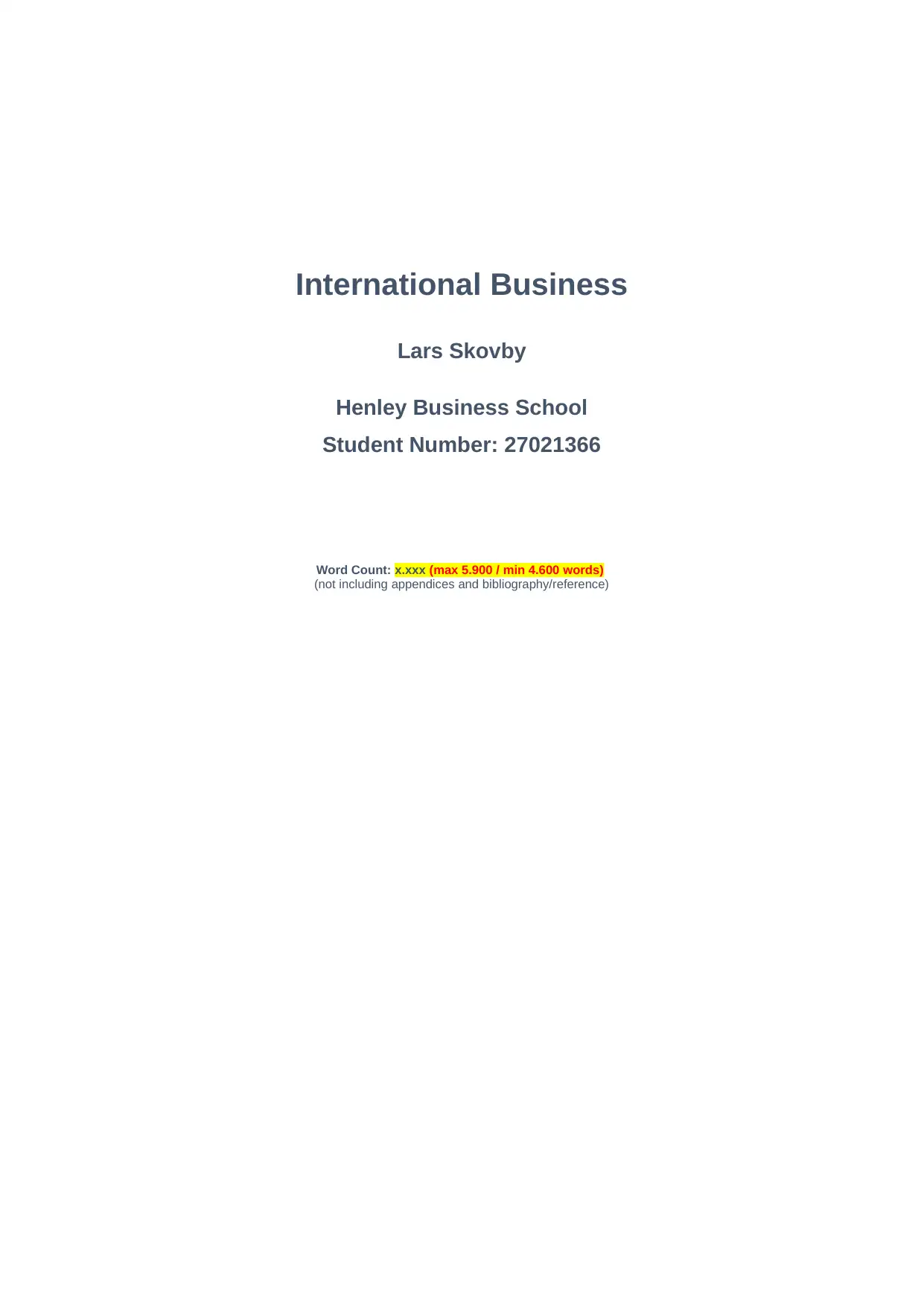
International Business
Lars Skovby
Henley Business School
Student Number: 27021366
Word Count: x.xxx (max 5.900 / min 4.600 words)
(not including appendices and bibliography/reference)
Lars Skovby IB Assignment Page 1 of 22
Lars Skovby
Henley Business School
Student Number: 27021366
Word Count: x.xxx (max 5.900 / min 4.600 words)
(not including appendices and bibliography/reference)
Lars Skovby IB Assignment Page 1 of 22
Paraphrase This Document
Need a fresh take? Get an instant paraphrase of this document with our AI Paraphraser
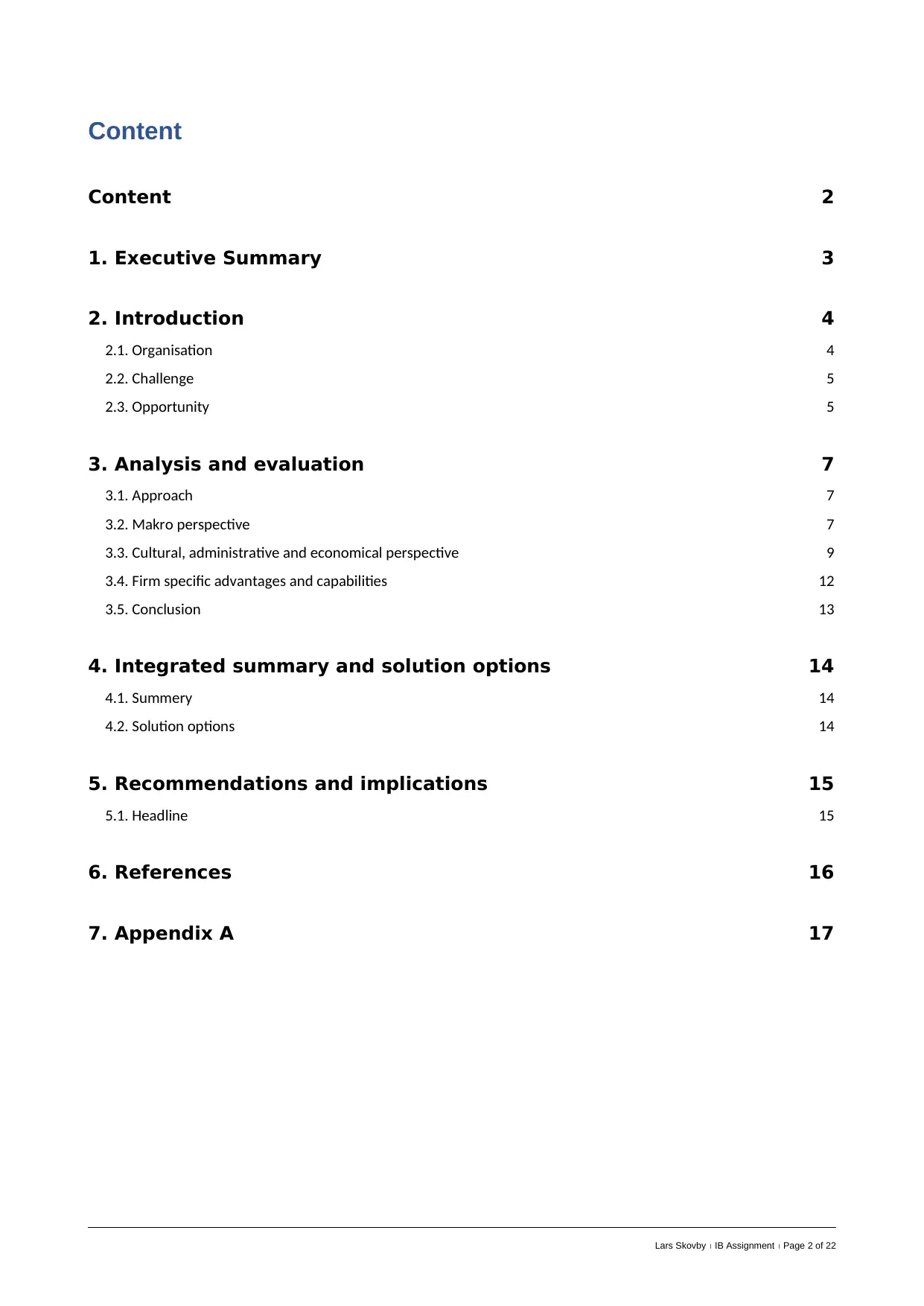
Content
Content 2
1. Executive Summary 3
2. Introduction 4
2.1. Organisation 4
2.2. Challenge 5
2.3. Opportunity 5
3. Analysis and evaluation 7
3.1. Approach 7
3.2. Makro perspective 7
3.3. Cultural, administrative and economical perspective 9
3.4. Firm specific advantages and capabilities 12
3.5. Conclusion 13
4. Integrated summary and solution options 14
4.1. Summery 14
4.2. Solution options 14
5. Recommendations and implications 15
5.1. Headline 15
6. References 16
7. Appendix A 17
Lars Skovby IB Assignment Page 2 of 22
Content 2
1. Executive Summary 3
2. Introduction 4
2.1. Organisation 4
2.2. Challenge 5
2.3. Opportunity 5
3. Analysis and evaluation 7
3.1. Approach 7
3.2. Makro perspective 7
3.3. Cultural, administrative and economical perspective 9
3.4. Firm specific advantages and capabilities 12
3.5. Conclusion 13
4. Integrated summary and solution options 14
4.1. Summery 14
4.2. Solution options 14
5. Recommendations and implications 15
5.1. Headline 15
6. References 16
7. Appendix A 17
Lars Skovby IB Assignment Page 2 of 22
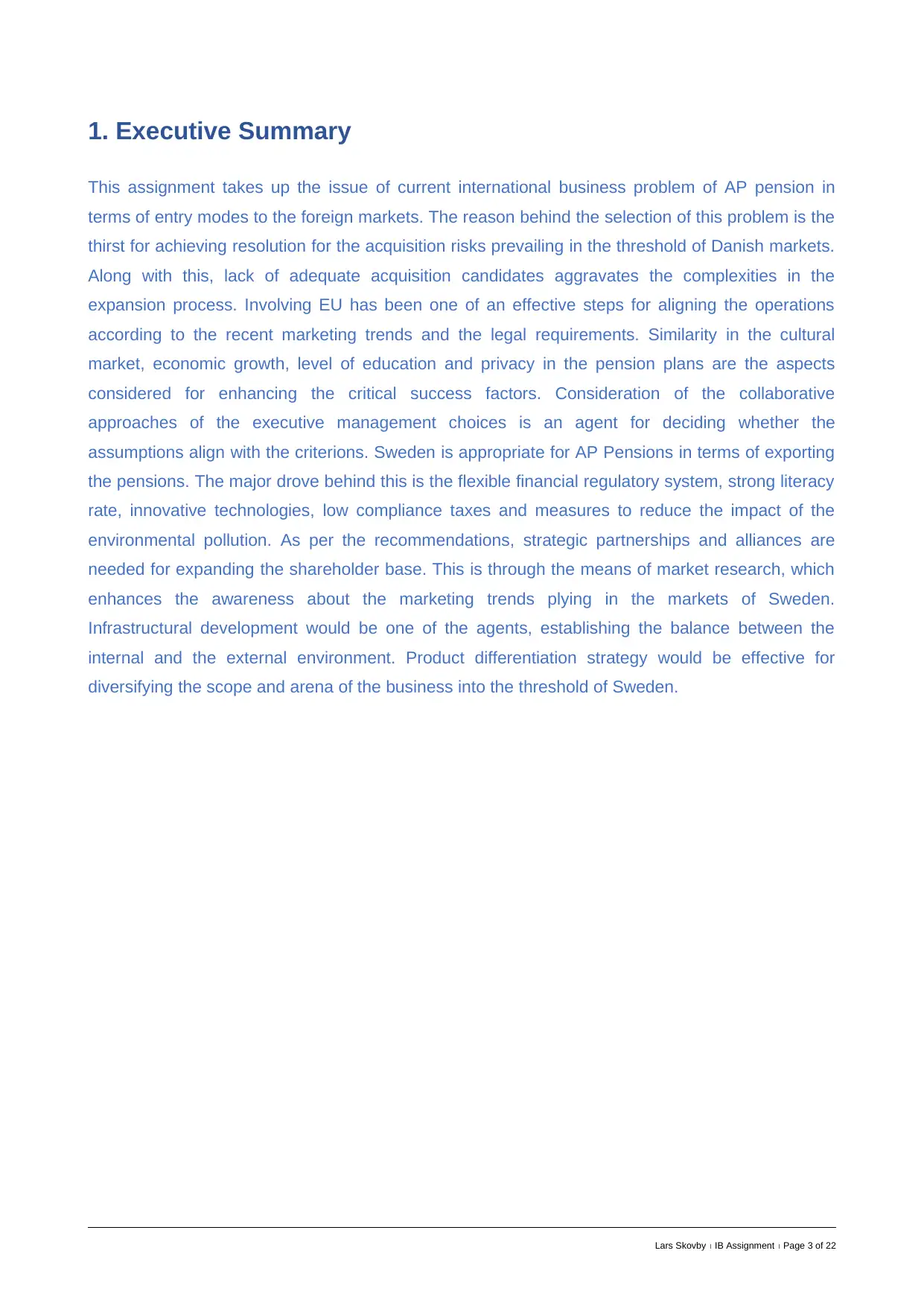
1. Executive Summary
This assignment takes up the issue of current international business problem of AP pension in
terms of entry modes to the foreign markets. The reason behind the selection of this problem is the
thirst for achieving resolution for the acquisition risks prevailing in the threshold of Danish markets.
Along with this, lack of adequate acquisition candidates aggravates the complexities in the
expansion process. Involving EU has been one of an effective steps for aligning the operations
according to the recent marketing trends and the legal requirements. Similarity in the cultural
market, economic growth, level of education and privacy in the pension plans are the aspects
considered for enhancing the critical success factors. Consideration of the collaborative
approaches of the executive management choices is an agent for deciding whether the
assumptions align with the criterions. Sweden is appropriate for AP Pensions in terms of exporting
the pensions. The major drove behind this is the flexible financial regulatory system, strong literacy
rate, innovative technologies, low compliance taxes and measures to reduce the impact of the
environmental pollution. As per the recommendations, strategic partnerships and alliances are
needed for expanding the shareholder base. This is through the means of market research, which
enhances the awareness about the marketing trends plying in the markets of Sweden.
Infrastructural development would be one of the agents, establishing the balance between the
internal and the external environment. Product differentiation strategy would be effective for
diversifying the scope and arena of the business into the threshold of Sweden.
Lars Skovby IB Assignment Page 3 of 22
This assignment takes up the issue of current international business problem of AP pension in
terms of entry modes to the foreign markets. The reason behind the selection of this problem is the
thirst for achieving resolution for the acquisition risks prevailing in the threshold of Danish markets.
Along with this, lack of adequate acquisition candidates aggravates the complexities in the
expansion process. Involving EU has been one of an effective steps for aligning the operations
according to the recent marketing trends and the legal requirements. Similarity in the cultural
market, economic growth, level of education and privacy in the pension plans are the aspects
considered for enhancing the critical success factors. Consideration of the collaborative
approaches of the executive management choices is an agent for deciding whether the
assumptions align with the criterions. Sweden is appropriate for AP Pensions in terms of exporting
the pensions. The major drove behind this is the flexible financial regulatory system, strong literacy
rate, innovative technologies, low compliance taxes and measures to reduce the impact of the
environmental pollution. As per the recommendations, strategic partnerships and alliances are
needed for expanding the shareholder base. This is through the means of market research, which
enhances the awareness about the marketing trends plying in the markets of Sweden.
Infrastructural development would be one of the agents, establishing the balance between the
internal and the external environment. Product differentiation strategy would be effective for
diversifying the scope and arena of the business into the threshold of Sweden.
Lars Skovby IB Assignment Page 3 of 22
⊘ This is a preview!⊘
Do you want full access?
Subscribe today to unlock all pages.

Trusted by 1+ million students worldwide
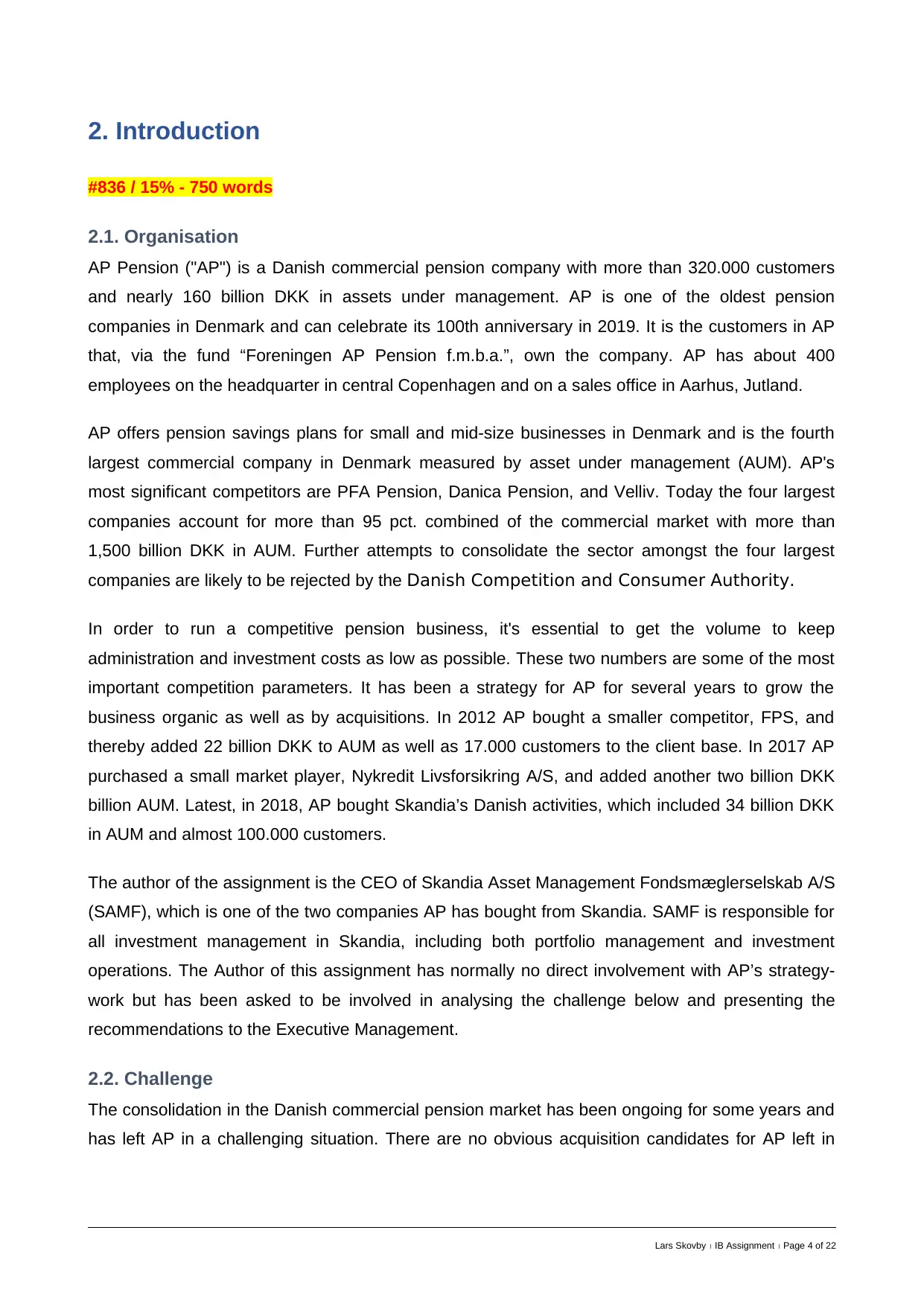
2. Introduction
#836 / 15% - 750 words
2.1. Organisation
AP Pension ("AP") is a Danish commercial pension company with more than 320.000 customers
and nearly 160 billion DKK in assets under management. AP is one of the oldest pension
companies in Denmark and can celebrate its 100th anniversary in 2019. It is the customers in AP
that, via the fund “Foreningen AP Pension f.m.b.a.”, own the company. AP has about 400
employees on the headquarter in central Copenhagen and on a sales office in Aarhus, Jutland.
AP offers pension savings plans for small and mid-size businesses in Denmark and is the fourth
largest commercial company in Denmark measured by asset under management (AUM). AP's
most significant competitors are PFA Pension, Danica Pension, and Velliv. Today the four largest
companies account for more than 95 pct. combined of the commercial market with more than
1,500 billion DKK in AUM. Further attempts to consolidate the sector amongst the four largest
companies are likely to be rejected by the Danish Competition and Consumer Authority.
In order to run a competitive pension business, it's essential to get the volume to keep
administration and investment costs as low as possible. These two numbers are some of the most
important competition parameters. It has been a strategy for AP for several years to grow the
business organic as well as by acquisitions. In 2012 AP bought a smaller competitor, FPS, and
thereby added 22 billion DKK to AUM as well as 17.000 customers to the client base. In 2017 AP
purchased a small market player, Nykredit Livsforsikring A/S, and added another two billion DKK
billion AUM. Latest, in 2018, AP bought Skandia’s Danish activities, which included 34 billion DKK
in AUM and almost 100.000 customers.
The author of the assignment is the CEO of Skandia Asset Management Fondsmæglerselskab A/S
(SAMF), which is one of the two companies AP has bought from Skandia. SAMF is responsible for
all investment management in Skandia, including both portfolio management and investment
operations. The Author of this assignment has normally no direct involvement with AP’s strategy-
work but has been asked to be involved in analysing the challenge below and presenting the
recommendations to the Executive Management.
2.2. Challenge
The consolidation in the Danish commercial pension market has been ongoing for some years and
has left AP in a challenging situation. There are no obvious acquisition candidates for AP left in
Lars Skovby IB Assignment Page 4 of 22
#836 / 15% - 750 words
2.1. Organisation
AP Pension ("AP") is a Danish commercial pension company with more than 320.000 customers
and nearly 160 billion DKK in assets under management. AP is one of the oldest pension
companies in Denmark and can celebrate its 100th anniversary in 2019. It is the customers in AP
that, via the fund “Foreningen AP Pension f.m.b.a.”, own the company. AP has about 400
employees on the headquarter in central Copenhagen and on a sales office in Aarhus, Jutland.
AP offers pension savings plans for small and mid-size businesses in Denmark and is the fourth
largest commercial company in Denmark measured by asset under management (AUM). AP's
most significant competitors are PFA Pension, Danica Pension, and Velliv. Today the four largest
companies account for more than 95 pct. combined of the commercial market with more than
1,500 billion DKK in AUM. Further attempts to consolidate the sector amongst the four largest
companies are likely to be rejected by the Danish Competition and Consumer Authority.
In order to run a competitive pension business, it's essential to get the volume to keep
administration and investment costs as low as possible. These two numbers are some of the most
important competition parameters. It has been a strategy for AP for several years to grow the
business organic as well as by acquisitions. In 2012 AP bought a smaller competitor, FPS, and
thereby added 22 billion DKK to AUM as well as 17.000 customers to the client base. In 2017 AP
purchased a small market player, Nykredit Livsforsikring A/S, and added another two billion DKK
billion AUM. Latest, in 2018, AP bought Skandia’s Danish activities, which included 34 billion DKK
in AUM and almost 100.000 customers.
The author of the assignment is the CEO of Skandia Asset Management Fondsmæglerselskab A/S
(SAMF), which is one of the two companies AP has bought from Skandia. SAMF is responsible for
all investment management in Skandia, including both portfolio management and investment
operations. The Author of this assignment has normally no direct involvement with AP’s strategy-
work but has been asked to be involved in analysing the challenge below and presenting the
recommendations to the Executive Management.
2.2. Challenge
The consolidation in the Danish commercial pension market has been ongoing for some years and
has left AP in a challenging situation. There are no obvious acquisition candidates for AP left in
Lars Skovby IB Assignment Page 4 of 22
Paraphrase This Document
Need a fresh take? Get an instant paraphrase of this document with our AI Paraphraser
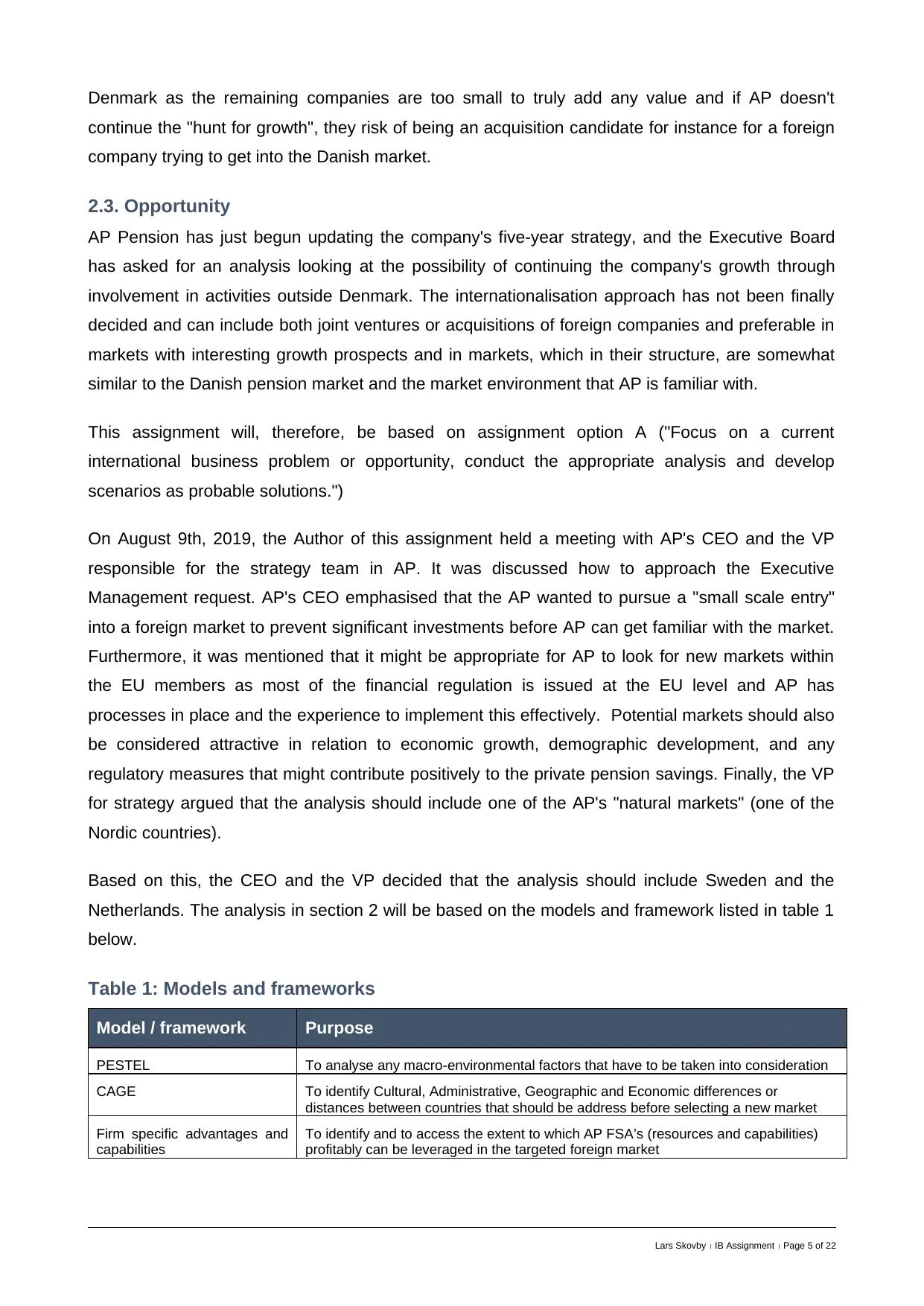
Denmark as the remaining companies are too small to truly add any value and if AP doesn't
continue the "hunt for growth", they risk of being an acquisition candidate for instance for a foreign
company trying to get into the Danish market.
2.3. Opportunity
AP Pension has just begun updating the company's five-year strategy, and the Executive Board
has asked for an analysis looking at the possibility of continuing the company's growth through
involvement in activities outside Denmark. The internationalisation approach has not been finally
decided and can include both joint ventures or acquisitions of foreign companies and preferable in
markets with interesting growth prospects and in markets, which in their structure, are somewhat
similar to the Danish pension market and the market environment that AP is familiar with.
This assignment will, therefore, be based on assignment option A ("Focus on a current
international business problem or opportunity, conduct the appropriate analysis and develop
scenarios as probable solutions.")
On August 9th, 2019, the Author of this assignment held a meeting with AP's CEO and the VP
responsible for the strategy team in AP. It was discussed how to approach the Executive
Management request. AP's CEO emphasised that the AP wanted to pursue a "small scale entry"
into a foreign market to prevent significant investments before AP can get familiar with the market.
Furthermore, it was mentioned that it might be appropriate for AP to look for new markets within
the EU members as most of the financial regulation is issued at the EU level and AP has
processes in place and the experience to implement this effectively. Potential markets should also
be considered attractive in relation to economic growth, demographic development, and any
regulatory measures that might contribute positively to the private pension savings. Finally, the VP
for strategy argued that the analysis should include one of the AP's "natural markets" (one of the
Nordic countries).
Based on this, the CEO and the VP decided that the analysis should include Sweden and the
Netherlands. The analysis in section 2 will be based on the models and framework listed in table 1
below.
Table 1: Models and frameworks
Model / framework Purpose
PESTEL To analyse any macro-environmental factors that have to be taken into consideration
CAGE To identify Cultural, Administrative, Geographic and Economic differences or
distances between countries that should be address before selecting a new market
Firm specific advantages and
capabilities
To identify and to access the extent to which AP FSA’s (resources and capabilities)
profitably can be leveraged in the targeted foreign market
Lars Skovby IB Assignment Page 5 of 22
continue the "hunt for growth", they risk of being an acquisition candidate for instance for a foreign
company trying to get into the Danish market.
2.3. Opportunity
AP Pension has just begun updating the company's five-year strategy, and the Executive Board
has asked for an analysis looking at the possibility of continuing the company's growth through
involvement in activities outside Denmark. The internationalisation approach has not been finally
decided and can include both joint ventures or acquisitions of foreign companies and preferable in
markets with interesting growth prospects and in markets, which in their structure, are somewhat
similar to the Danish pension market and the market environment that AP is familiar with.
This assignment will, therefore, be based on assignment option A ("Focus on a current
international business problem or opportunity, conduct the appropriate analysis and develop
scenarios as probable solutions.")
On August 9th, 2019, the Author of this assignment held a meeting with AP's CEO and the VP
responsible for the strategy team in AP. It was discussed how to approach the Executive
Management request. AP's CEO emphasised that the AP wanted to pursue a "small scale entry"
into a foreign market to prevent significant investments before AP can get familiar with the market.
Furthermore, it was mentioned that it might be appropriate for AP to look for new markets within
the EU members as most of the financial regulation is issued at the EU level and AP has
processes in place and the experience to implement this effectively. Potential markets should also
be considered attractive in relation to economic growth, demographic development, and any
regulatory measures that might contribute positively to the private pension savings. Finally, the VP
for strategy argued that the analysis should include one of the AP's "natural markets" (one of the
Nordic countries).
Based on this, the CEO and the VP decided that the analysis should include Sweden and the
Netherlands. The analysis in section 2 will be based on the models and framework listed in table 1
below.
Table 1: Models and frameworks
Model / framework Purpose
PESTEL To analyse any macro-environmental factors that have to be taken into consideration
CAGE To identify Cultural, Administrative, Geographic and Economic differences or
distances between countries that should be address before selecting a new market
Firm specific advantages and
capabilities
To identify and to access the extent to which AP FSA’s (resources and capabilities)
profitably can be leveraged in the targeted foreign market
Lars Skovby IB Assignment Page 5 of 22
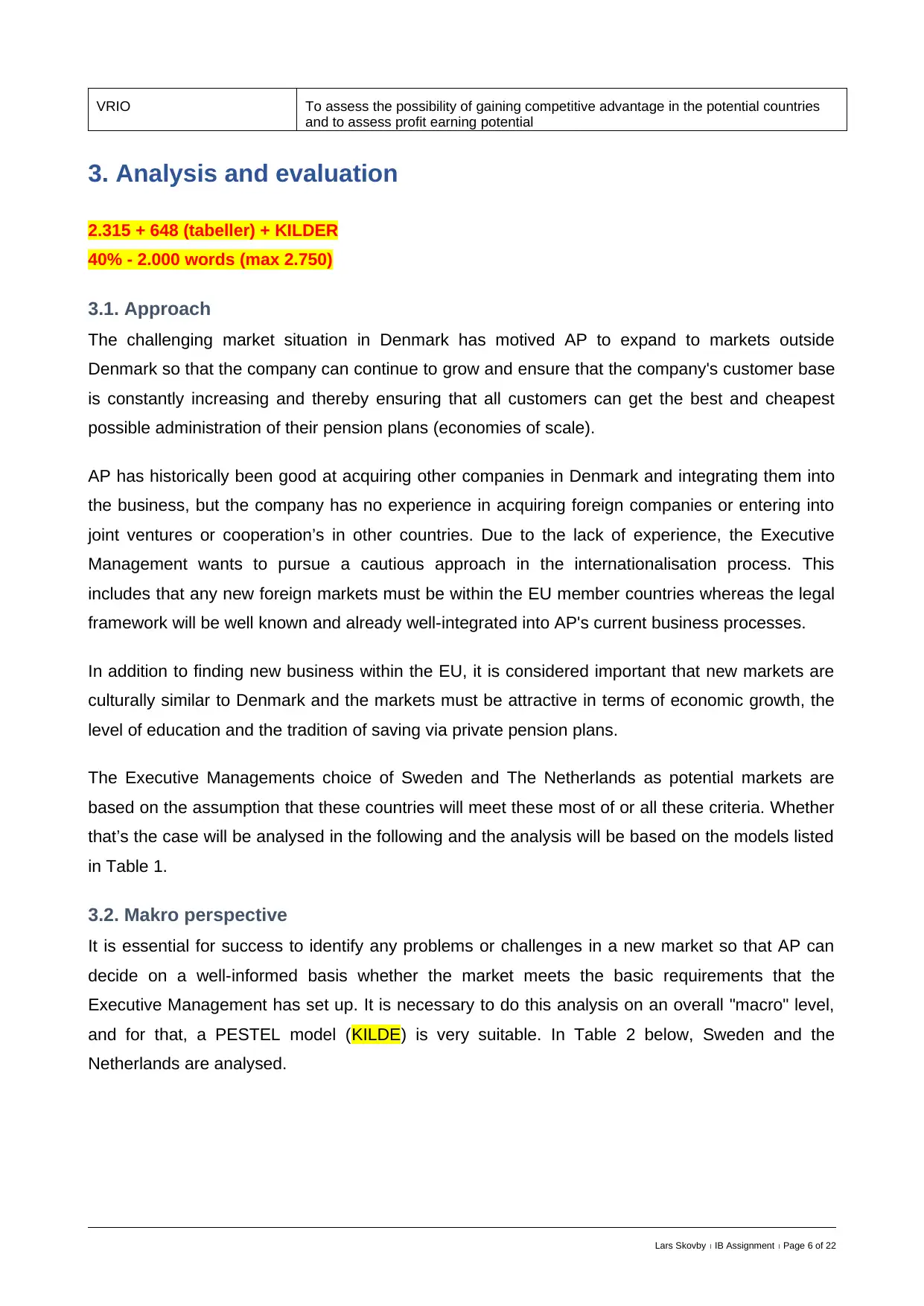
VRIO To assess the possibility of gaining competitive advantage in the potential countries
and to assess profit earning potential
3. Analysis and evaluation
2.315 + 648 (tabeller) + KILDER
40% - 2.000 words (max 2.750)
3.1. Approach
The challenging market situation in Denmark has motived AP to expand to markets outside
Denmark so that the company can continue to grow and ensure that the company's customer base
is constantly increasing and thereby ensuring that all customers can get the best and cheapest
possible administration of their pension plans (economies of scale).
AP has historically been good at acquiring other companies in Denmark and integrating them into
the business, but the company has no experience in acquiring foreign companies or entering into
joint ventures or cooperation’s in other countries. Due to the lack of experience, the Executive
Management wants to pursue a cautious approach in the internationalisation process. This
includes that any new foreign markets must be within the EU member countries whereas the legal
framework will be well known and already well-integrated into AP's current business processes.
In addition to finding new business within the EU, it is considered important that new markets are
culturally similar to Denmark and the markets must be attractive in terms of economic growth, the
level of education and the tradition of saving via private pension plans.
The Executive Managements choice of Sweden and The Netherlands as potential markets are
based on the assumption that these countries will meet these most of or all these criteria. Whether
that’s the case will be analysed in the following and the analysis will be based on the models listed
in Table 1.
3.2. Makro perspective
It is essential for success to identify any problems or challenges in a new market so that AP can
decide on a well-informed basis whether the market meets the basic requirements that the
Executive Management has set up. It is necessary to do this analysis on an overall "macro" level,
and for that, a PESTEL model (KILDE) is very suitable. In Table 2 below, Sweden and the
Netherlands are analysed.
Lars Skovby IB Assignment Page 6 of 22
and to assess profit earning potential
3. Analysis and evaluation
2.315 + 648 (tabeller) + KILDER
40% - 2.000 words (max 2.750)
3.1. Approach
The challenging market situation in Denmark has motived AP to expand to markets outside
Denmark so that the company can continue to grow and ensure that the company's customer base
is constantly increasing and thereby ensuring that all customers can get the best and cheapest
possible administration of their pension plans (economies of scale).
AP has historically been good at acquiring other companies in Denmark and integrating them into
the business, but the company has no experience in acquiring foreign companies or entering into
joint ventures or cooperation’s in other countries. Due to the lack of experience, the Executive
Management wants to pursue a cautious approach in the internationalisation process. This
includes that any new foreign markets must be within the EU member countries whereas the legal
framework will be well known and already well-integrated into AP's current business processes.
In addition to finding new business within the EU, it is considered important that new markets are
culturally similar to Denmark and the markets must be attractive in terms of economic growth, the
level of education and the tradition of saving via private pension plans.
The Executive Managements choice of Sweden and The Netherlands as potential markets are
based on the assumption that these countries will meet these most of or all these criteria. Whether
that’s the case will be analysed in the following and the analysis will be based on the models listed
in Table 1.
3.2. Makro perspective
It is essential for success to identify any problems or challenges in a new market so that AP can
decide on a well-informed basis whether the market meets the basic requirements that the
Executive Management has set up. It is necessary to do this analysis on an overall "macro" level,
and for that, a PESTEL model (KILDE) is very suitable. In Table 2 below, Sweden and the
Netherlands are analysed.
Lars Skovby IB Assignment Page 6 of 22
⊘ This is a preview!⊘
Do you want full access?
Subscribe today to unlock all pages.

Trusted by 1+ million students worldwide
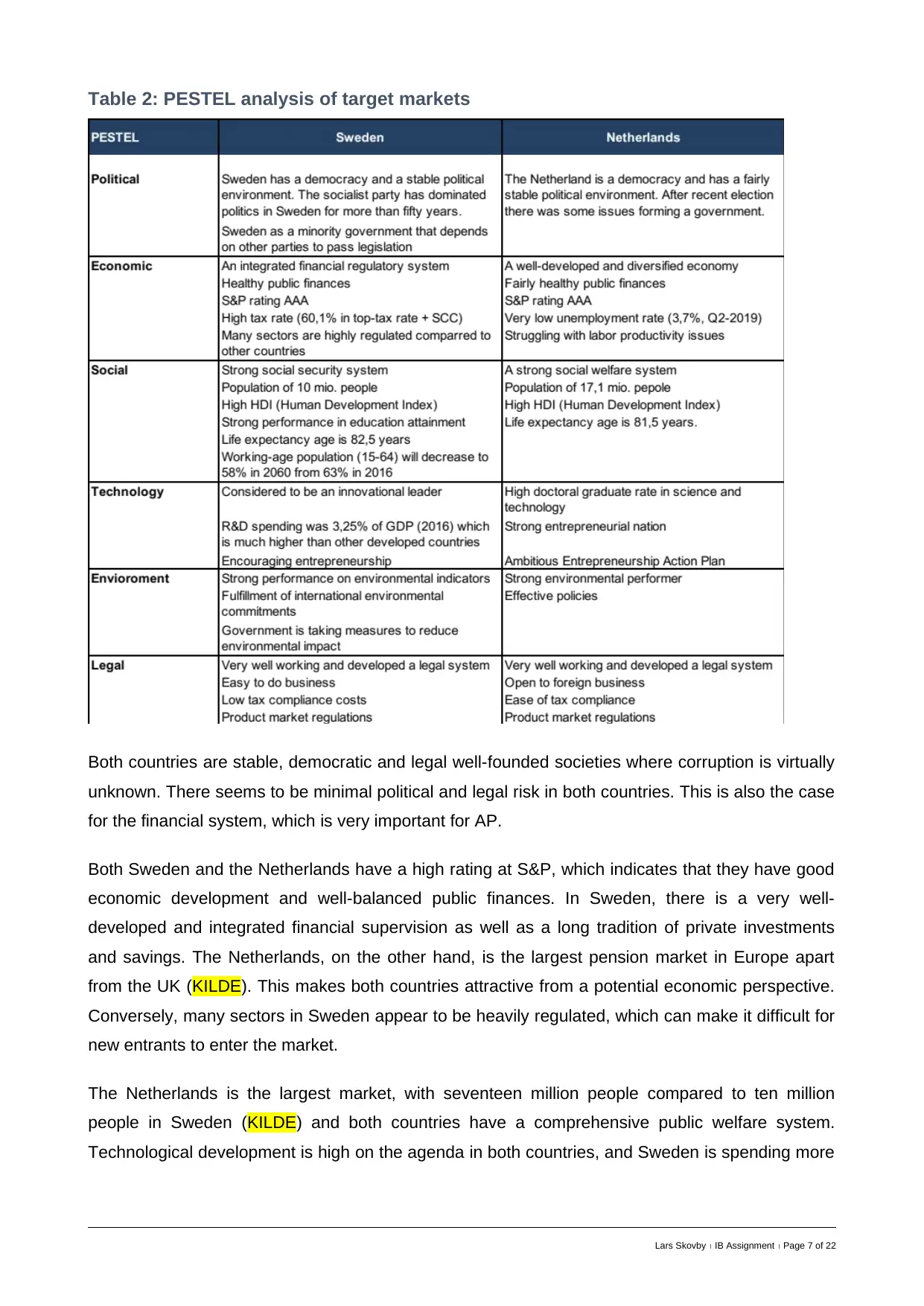
Table 2: PESTEL analysis of target markets
Both countries are stable, democratic and legal well-founded societies where corruption is virtually
unknown. There seems to be minimal political and legal risk in both countries. This is also the case
for the financial system, which is very important for AP.
Both Sweden and the Netherlands have a high rating at S&P, which indicates that they have good
economic development and well-balanced public finances. In Sweden, there is a very well-
developed and integrated financial supervision as well as a long tradition of private investments
and savings. The Netherlands, on the other hand, is the largest pension market in Europe apart
from the UK (KILDE). This makes both countries attractive from a potential economic perspective.
Conversely, many sectors in Sweden appear to be heavily regulated, which can make it difficult for
new entrants to enter the market.
The Netherlands is the largest market, with seventeen million people compared to ten million
people in Sweden (KILDE) and both countries have a comprehensive public welfare system.
Technological development is high on the agenda in both countries, and Sweden is spending more
Lars Skovby IB Assignment Page 7 of 22
Both countries are stable, democratic and legal well-founded societies where corruption is virtually
unknown. There seems to be minimal political and legal risk in both countries. This is also the case
for the financial system, which is very important for AP.
Both Sweden and the Netherlands have a high rating at S&P, which indicates that they have good
economic development and well-balanced public finances. In Sweden, there is a very well-
developed and integrated financial supervision as well as a long tradition of private investments
and savings. The Netherlands, on the other hand, is the largest pension market in Europe apart
from the UK (KILDE). This makes both countries attractive from a potential economic perspective.
Conversely, many sectors in Sweden appear to be heavily regulated, which can make it difficult for
new entrants to enter the market.
The Netherlands is the largest market, with seventeen million people compared to ten million
people in Sweden (KILDE) and both countries have a comprehensive public welfare system.
Technological development is high on the agenda in both countries, and Sweden is spending more
Lars Skovby IB Assignment Page 7 of 22
Paraphrase This Document
Need a fresh take? Get an instant paraphrase of this document with our AI Paraphraser
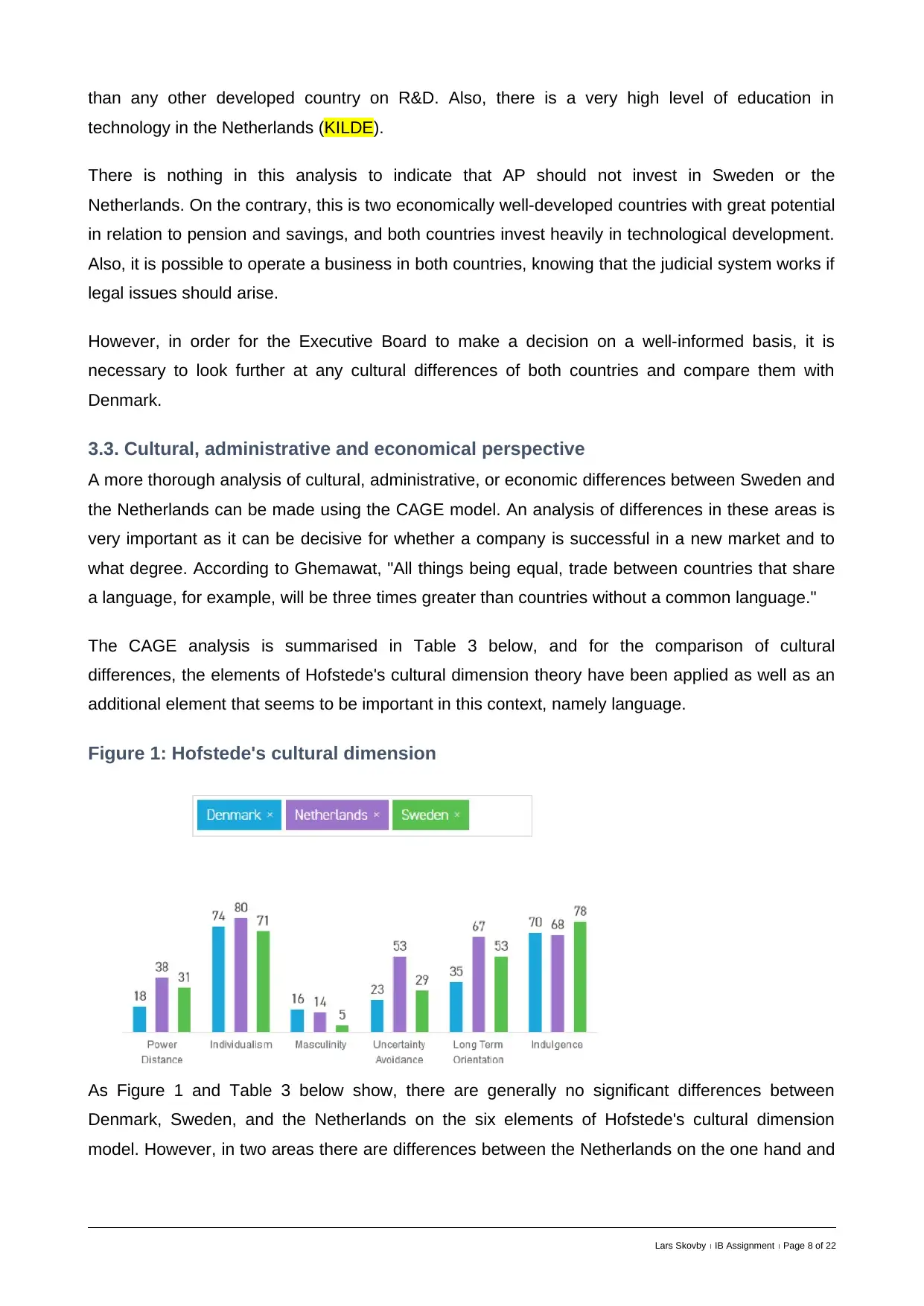
than any other developed country on R&D. Also, there is a very high level of education in
technology in the Netherlands (KILDE).
There is nothing in this analysis to indicate that AP should not invest in Sweden or the
Netherlands. On the contrary, this is two economically well-developed countries with great potential
in relation to pension and savings, and both countries invest heavily in technological development.
Also, it is possible to operate a business in both countries, knowing that the judicial system works if
legal issues should arise.
However, in order for the Executive Board to make a decision on a well-informed basis, it is
necessary to look further at any cultural differences of both countries and compare them with
Denmark.
3.3. Cultural, administrative and economical perspective
A more thorough analysis of cultural, administrative, or economic differences between Sweden and
the Netherlands can be made using the CAGE model. An analysis of differences in these areas is
very important as it can be decisive for whether a company is successful in a new market and to
what degree. According to Ghemawat, "All things being equal, trade between countries that share
a language, for example, will be three times greater than countries without a common language."
The CAGE analysis is summarised in Table 3 below, and for the comparison of cultural
differences, the elements of Hofstede's cultural dimension theory have been applied as well as an
additional element that seems to be important in this context, namely language.
Figure 1: Hofstede's cultural dimension
As Figure 1 and Table 3 below show, there are generally no significant differences between
Denmark, Sweden, and the Netherlands on the six elements of Hofstede's cultural dimension
model. However, in two areas there are differences between the Netherlands on the one hand and
Lars Skovby IB Assignment Page 8 of 22
technology in the Netherlands (KILDE).
There is nothing in this analysis to indicate that AP should not invest in Sweden or the
Netherlands. On the contrary, this is two economically well-developed countries with great potential
in relation to pension and savings, and both countries invest heavily in technological development.
Also, it is possible to operate a business in both countries, knowing that the judicial system works if
legal issues should arise.
However, in order for the Executive Board to make a decision on a well-informed basis, it is
necessary to look further at any cultural differences of both countries and compare them with
Denmark.
3.3. Cultural, administrative and economical perspective
A more thorough analysis of cultural, administrative, or economic differences between Sweden and
the Netherlands can be made using the CAGE model. An analysis of differences in these areas is
very important as it can be decisive for whether a company is successful in a new market and to
what degree. According to Ghemawat, "All things being equal, trade between countries that share
a language, for example, will be three times greater than countries without a common language."
The CAGE analysis is summarised in Table 3 below, and for the comparison of cultural
differences, the elements of Hofstede's cultural dimension theory have been applied as well as an
additional element that seems to be important in this context, namely language.
Figure 1: Hofstede's cultural dimension
As Figure 1 and Table 3 below show, there are generally no significant differences between
Denmark, Sweden, and the Netherlands on the six elements of Hofstede's cultural dimension
model. However, in two areas there are differences between the Netherlands on the one hand and
Lars Skovby IB Assignment Page 8 of 22
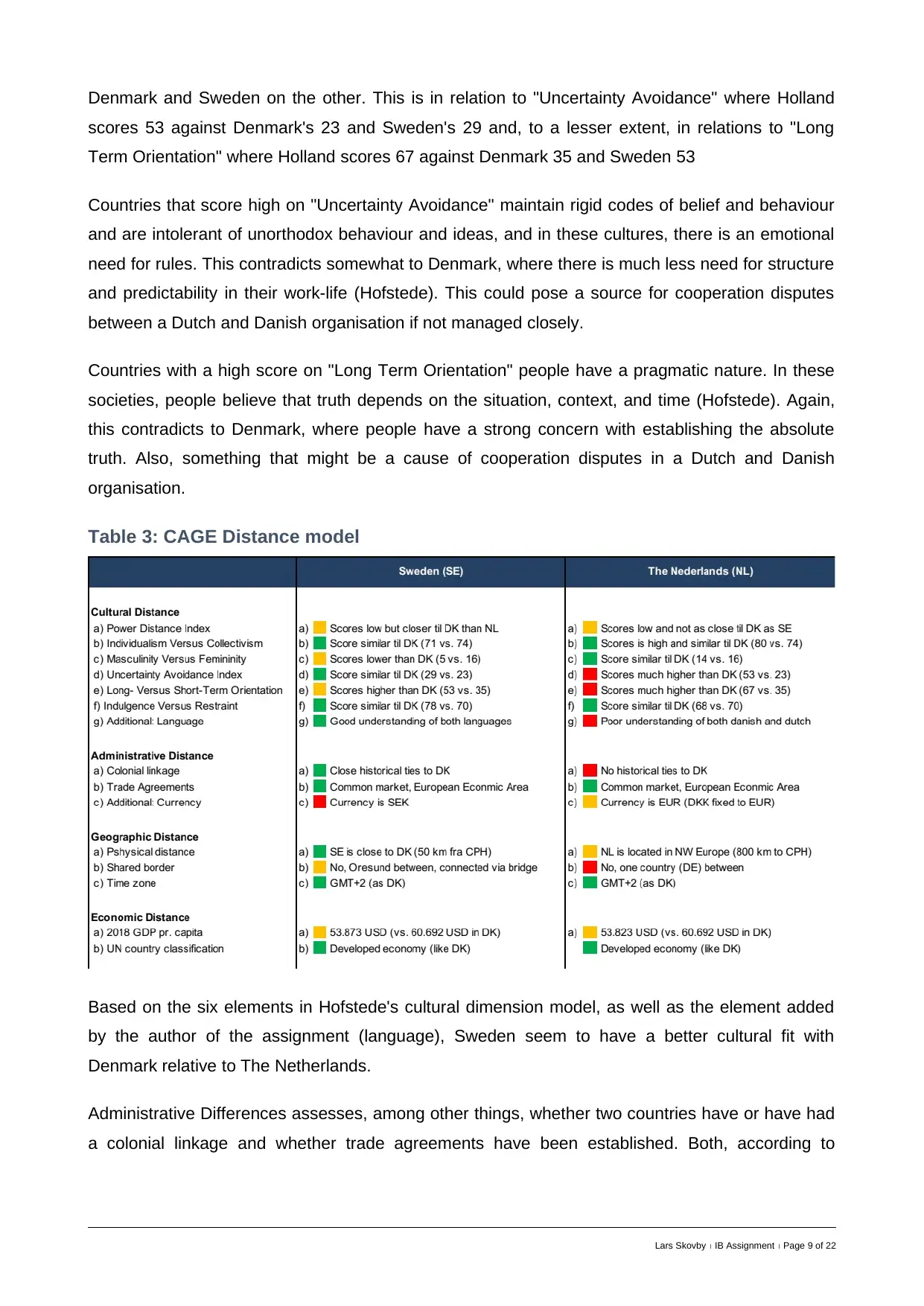
Denmark and Sweden on the other. This is in relation to "Uncertainty Avoidance" where Holland
scores 53 against Denmark's 23 and Sweden's 29 and, to a lesser extent, in relations to "Long
Term Orientation" where Holland scores 67 against Denmark 35 and Sweden 53
Countries that score high on "Uncertainty Avoidance" maintain rigid codes of belief and behaviour
and are intolerant of unorthodox behaviour and ideas, and in these cultures, there is an emotional
need for rules. This contradicts somewhat to Denmark, where there is much less need for structure
and predictability in their work-life (Hofstede). This could pose a source for cooperation disputes
between a Dutch and Danish organisation if not managed closely.
Countries with a high score on "Long Term Orientation" people have a pragmatic nature. In these
societies, people believe that truth depends on the situation, context, and time (Hofstede). Again,
this contradicts to Denmark, where people have a strong concern with establishing the absolute
truth. Also, something that might be a cause of cooperation disputes in a Dutch and Danish
organisation.
Table 3: CAGE Distance model
Based on the six elements in Hofstede's cultural dimension model, as well as the element added
by the author of the assignment (language), Sweden seem to have a better cultural fit with
Denmark relative to The Netherlands.
Administrative Differences assesses, among other things, whether two countries have or have had
a colonial linkage and whether trade agreements have been established. Both, according to
Lars Skovby IB Assignment Page 9 of 22
scores 53 against Denmark's 23 and Sweden's 29 and, to a lesser extent, in relations to "Long
Term Orientation" where Holland scores 67 against Denmark 35 and Sweden 53
Countries that score high on "Uncertainty Avoidance" maintain rigid codes of belief and behaviour
and are intolerant of unorthodox behaviour and ideas, and in these cultures, there is an emotional
need for rules. This contradicts somewhat to Denmark, where there is much less need for structure
and predictability in their work-life (Hofstede). This could pose a source for cooperation disputes
between a Dutch and Danish organisation if not managed closely.
Countries with a high score on "Long Term Orientation" people have a pragmatic nature. In these
societies, people believe that truth depends on the situation, context, and time (Hofstede). Again,
this contradicts to Denmark, where people have a strong concern with establishing the absolute
truth. Also, something that might be a cause of cooperation disputes in a Dutch and Danish
organisation.
Table 3: CAGE Distance model
Based on the six elements in Hofstede's cultural dimension model, as well as the element added
by the author of the assignment (language), Sweden seem to have a better cultural fit with
Denmark relative to The Netherlands.
Administrative Differences assesses, among other things, whether two countries have or have had
a colonial linkage and whether trade agreements have been established. Both, according to
Lars Skovby IB Assignment Page 9 of 22
⊘ This is a preview!⊘
Do you want full access?
Subscribe today to unlock all pages.

Trusted by 1+ million students worldwide
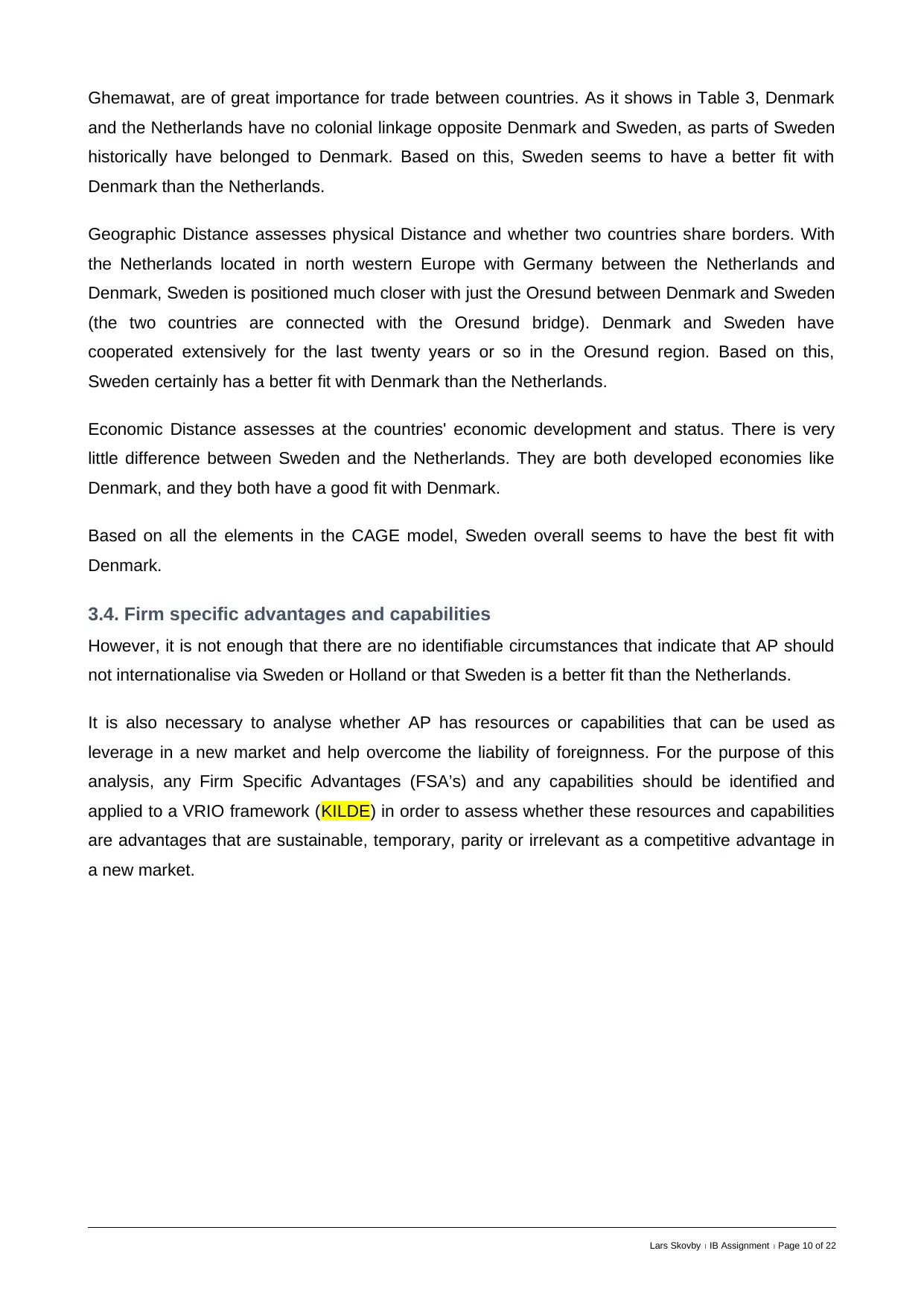
Ghemawat, are of great importance for trade between countries. As it shows in Table 3, Denmark
and the Netherlands have no colonial linkage opposite Denmark and Sweden, as parts of Sweden
historically have belonged to Denmark. Based on this, Sweden seems to have a better fit with
Denmark than the Netherlands.
Geographic Distance assesses physical Distance and whether two countries share borders. With
the Netherlands located in north western Europe with Germany between the Netherlands and
Denmark, Sweden is positioned much closer with just the Oresund between Denmark and Sweden
(the two countries are connected with the Oresund bridge). Denmark and Sweden have
cooperated extensively for the last twenty years or so in the Oresund region. Based on this,
Sweden certainly has a better fit with Denmark than the Netherlands.
Economic Distance assesses at the countries' economic development and status. There is very
little difference between Sweden and the Netherlands. They are both developed economies like
Denmark, and they both have a good fit with Denmark.
Based on all the elements in the CAGE model, Sweden overall seems to have the best fit with
Denmark.
3.4. Firm specific advantages and capabilities
However, it is not enough that there are no identifiable circumstances that indicate that AP should
not internationalise via Sweden or Holland or that Sweden is a better fit than the Netherlands.
It is also necessary to analyse whether AP has resources or capabilities that can be used as
leverage in a new market and help overcome the liability of foreignness. For the purpose of this
analysis, any Firm Specific Advantages (FSA’s) and any capabilities should be identified and
applied to a VRIO framework (KILDE) in order to assess whether these resources and capabilities
are advantages that are sustainable, temporary, parity or irrelevant as a competitive advantage in
a new market.
Lars Skovby IB Assignment Page 10 of 22
and the Netherlands have no colonial linkage opposite Denmark and Sweden, as parts of Sweden
historically have belonged to Denmark. Based on this, Sweden seems to have a better fit with
Denmark than the Netherlands.
Geographic Distance assesses physical Distance and whether two countries share borders. With
the Netherlands located in north western Europe with Germany between the Netherlands and
Denmark, Sweden is positioned much closer with just the Oresund between Denmark and Sweden
(the two countries are connected with the Oresund bridge). Denmark and Sweden have
cooperated extensively for the last twenty years or so in the Oresund region. Based on this,
Sweden certainly has a better fit with Denmark than the Netherlands.
Economic Distance assesses at the countries' economic development and status. There is very
little difference between Sweden and the Netherlands. They are both developed economies like
Denmark, and they both have a good fit with Denmark.
Based on all the elements in the CAGE model, Sweden overall seems to have the best fit with
Denmark.
3.4. Firm specific advantages and capabilities
However, it is not enough that there are no identifiable circumstances that indicate that AP should
not internationalise via Sweden or Holland or that Sweden is a better fit than the Netherlands.
It is also necessary to analyse whether AP has resources or capabilities that can be used as
leverage in a new market and help overcome the liability of foreignness. For the purpose of this
analysis, any Firm Specific Advantages (FSA’s) and any capabilities should be identified and
applied to a VRIO framework (KILDE) in order to assess whether these resources and capabilities
are advantages that are sustainable, temporary, parity or irrelevant as a competitive advantage in
a new market.
Lars Skovby IB Assignment Page 10 of 22
Paraphrase This Document
Need a fresh take? Get an instant paraphrase of this document with our AI Paraphraser
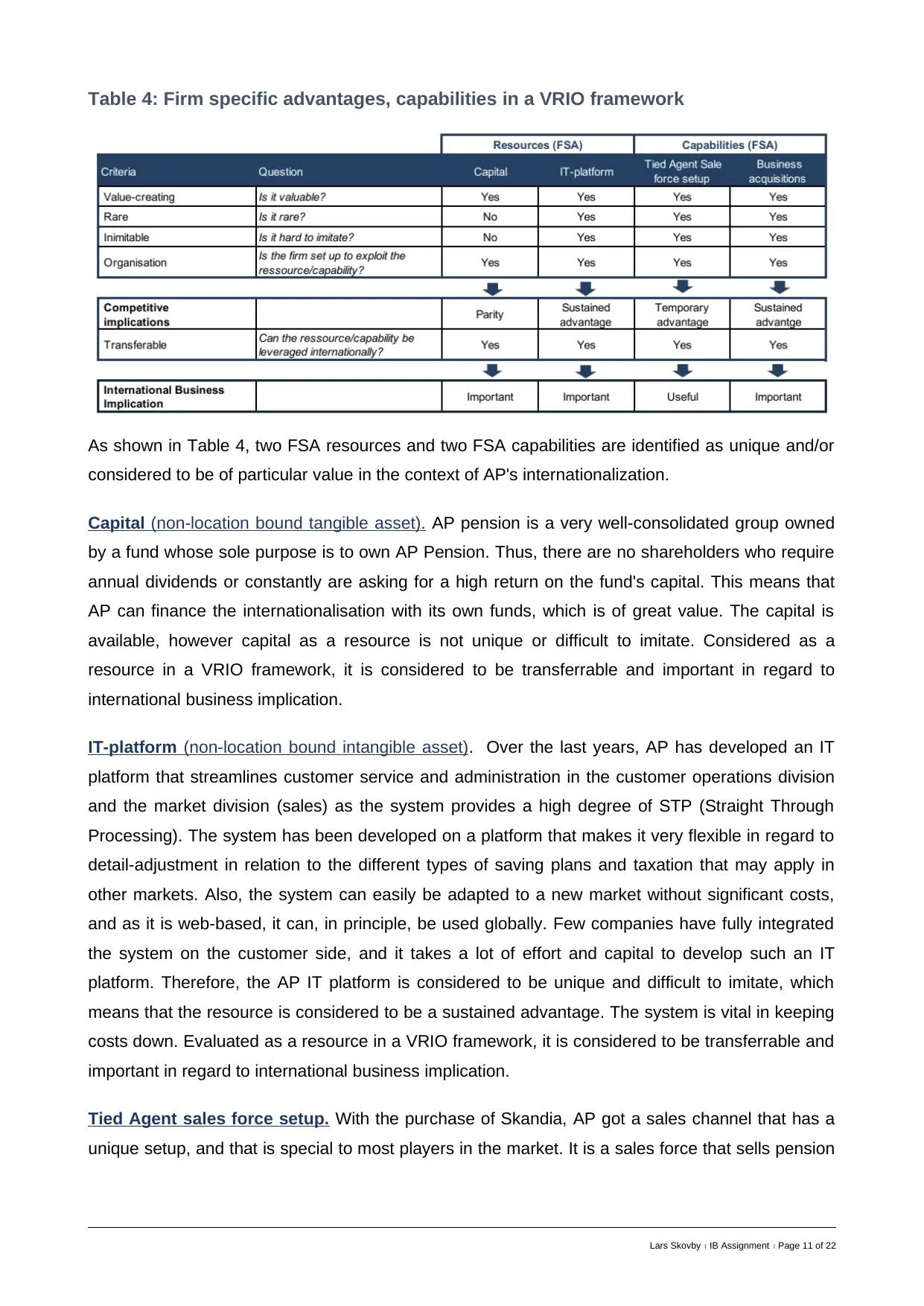
Table 4: Firm specific advantages, capabilities in a VRIO framework
As shown in Table 4, two FSA resources and two FSA capabilities are identified as unique and/or
considered to be of particular value in the context of AP's internationalization.
Capital (non-location bound tangible asset). AP pension is a very well-consolidated group owned
by a fund whose sole purpose is to own AP Pension. Thus, there are no shareholders who require
annual dividends or constantly are asking for a high return on the fund's capital. This means that
AP can finance the internationalisation with its own funds, which is of great value. The capital is
available, however capital as a resource is not unique or difficult to imitate. Considered as a
resource in a VRIO framework, it is considered to be transferrable and important in regard to
international business implication.
IT-platform (non-location bound intangible asset). Over the last years, AP has developed an IT
platform that streamlines customer service and administration in the customer operations division
and the market division (sales) as the system provides a high degree of STP (Straight Through
Processing). The system has been developed on a platform that makes it very flexible in regard to
detail-adjustment in relation to the different types of saving plans and taxation that may apply in
other markets. Also, the system can easily be adapted to a new market without significant costs,
and as it is web-based, it can, in principle, be used globally. Few companies have fully integrated
the system on the customer side, and it takes a lot of effort and capital to develop such an IT
platform. Therefore, the AP IT platform is considered to be unique and difficult to imitate, which
means that the resource is considered to be a sustained advantage. The system is vital in keeping
costs down. Evaluated as a resource in a VRIO framework, it is considered to be transferrable and
important in regard to international business implication.
Tied Agent sales force setup. With the purchase of Skandia, AP got a sales channel that has a
unique setup, and that is special to most players in the market. It is a sales force that sells pension
Lars Skovby IB Assignment Page 11 of 22
As shown in Table 4, two FSA resources and two FSA capabilities are identified as unique and/or
considered to be of particular value in the context of AP's internationalization.
Capital (non-location bound tangible asset). AP pension is a very well-consolidated group owned
by a fund whose sole purpose is to own AP Pension. Thus, there are no shareholders who require
annual dividends or constantly are asking for a high return on the fund's capital. This means that
AP can finance the internationalisation with its own funds, which is of great value. The capital is
available, however capital as a resource is not unique or difficult to imitate. Considered as a
resource in a VRIO framework, it is considered to be transferrable and important in regard to
international business implication.
IT-platform (non-location bound intangible asset). Over the last years, AP has developed an IT
platform that streamlines customer service and administration in the customer operations division
and the market division (sales) as the system provides a high degree of STP (Straight Through
Processing). The system has been developed on a platform that makes it very flexible in regard to
detail-adjustment in relation to the different types of saving plans and taxation that may apply in
other markets. Also, the system can easily be adapted to a new market without significant costs,
and as it is web-based, it can, in principle, be used globally. Few companies have fully integrated
the system on the customer side, and it takes a lot of effort and capital to develop such an IT
platform. Therefore, the AP IT platform is considered to be unique and difficult to imitate, which
means that the resource is considered to be a sustained advantage. The system is vital in keeping
costs down. Evaluated as a resource in a VRIO framework, it is considered to be transferrable and
important in regard to international business implication.
Tied Agent sales force setup. With the purchase of Skandia, AP got a sales channel that has a
unique setup, and that is special to most players in the market. It is a sales force that sells pension
Lars Skovby IB Assignment Page 11 of 22
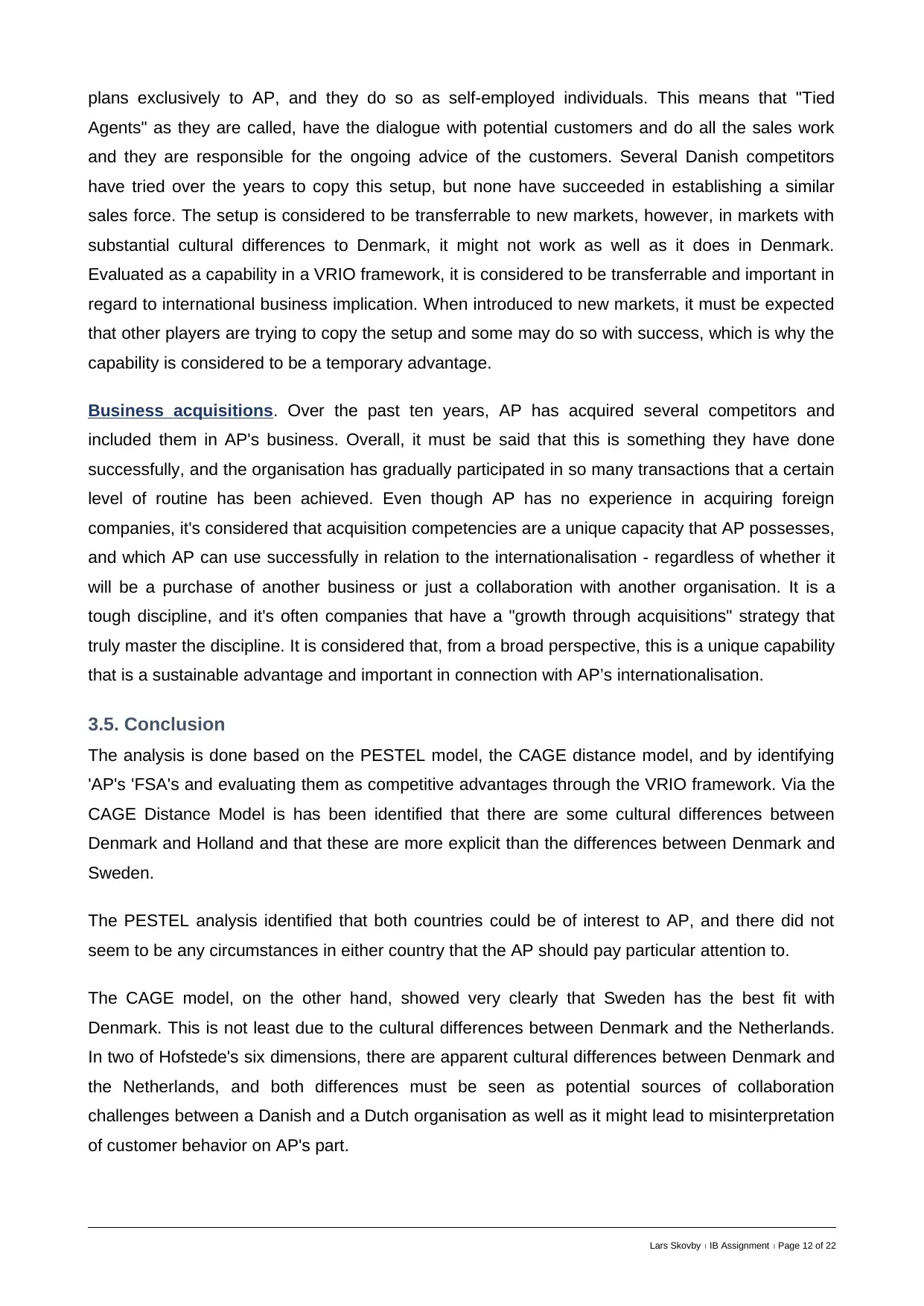
plans exclusively to AP, and they do so as self-employed individuals. This means that "Tied
Agents" as they are called, have the dialogue with potential customers and do all the sales work
and they are responsible for the ongoing advice of the customers. Several Danish competitors
have tried over the years to copy this setup, but none have succeeded in establishing a similar
sales force. The setup is considered to be transferrable to new markets, however, in markets with
substantial cultural differences to Denmark, it might not work as well as it does in Denmark.
Evaluated as a capability in a VRIO framework, it is considered to be transferrable and important in
regard to international business implication. When introduced to new markets, it must be expected
that other players are trying to copy the setup and some may do so with success, which is why the
capability is considered to be a temporary advantage.
Business acquisitions. Over the past ten years, AP has acquired several competitors and
included them in AP's business. Overall, it must be said that this is something they have done
successfully, and the organisation has gradually participated in so many transactions that a certain
level of routine has been achieved. Even though AP has no experience in acquiring foreign
companies, it's considered that acquisition competencies are a unique capacity that AP possesses,
and which AP can use successfully in relation to the internationalisation - regardless of whether it
will be a purchase of another business or just a collaboration with another organisation. It is a
tough discipline, and it's often companies that have a "growth through acquisitions" strategy that
truly master the discipline. It is considered that, from a broad perspective, this is a unique capability
that is a sustainable advantage and important in connection with AP’s internationalisation.
3.5. Conclusion
The analysis is done based on the PESTEL model, the CAGE distance model, and by identifying
'AP's 'FSA's and evaluating them as competitive advantages through the VRIO framework. Via the
CAGE Distance Model is has been identified that there are some cultural differences between
Denmark and Holland and that these are more explicit than the differences between Denmark and
Sweden.
The PESTEL analysis identified that both countries could be of interest to AP, and there did not
seem to be any circumstances in either country that the AP should pay particular attention to.
The CAGE model, on the other hand, showed very clearly that Sweden has the best fit with
Denmark. This is not least due to the cultural differences between Denmark and the Netherlands.
In two of Hofstede's six dimensions, there are apparent cultural differences between Denmark and
the Netherlands, and both differences must be seen as potential sources of collaboration
challenges between a Danish and a Dutch organisation as well as it might lead to misinterpretation
of customer behavior on AP's part.
Lars Skovby IB Assignment Page 12 of 22
Agents" as they are called, have the dialogue with potential customers and do all the sales work
and they are responsible for the ongoing advice of the customers. Several Danish competitors
have tried over the years to copy this setup, but none have succeeded in establishing a similar
sales force. The setup is considered to be transferrable to new markets, however, in markets with
substantial cultural differences to Denmark, it might not work as well as it does in Denmark.
Evaluated as a capability in a VRIO framework, it is considered to be transferrable and important in
regard to international business implication. When introduced to new markets, it must be expected
that other players are trying to copy the setup and some may do so with success, which is why the
capability is considered to be a temporary advantage.
Business acquisitions. Over the past ten years, AP has acquired several competitors and
included them in AP's business. Overall, it must be said that this is something they have done
successfully, and the organisation has gradually participated in so many transactions that a certain
level of routine has been achieved. Even though AP has no experience in acquiring foreign
companies, it's considered that acquisition competencies are a unique capacity that AP possesses,
and which AP can use successfully in relation to the internationalisation - regardless of whether it
will be a purchase of another business or just a collaboration with another organisation. It is a
tough discipline, and it's often companies that have a "growth through acquisitions" strategy that
truly master the discipline. It is considered that, from a broad perspective, this is a unique capability
that is a sustainable advantage and important in connection with AP’s internationalisation.
3.5. Conclusion
The analysis is done based on the PESTEL model, the CAGE distance model, and by identifying
'AP's 'FSA's and evaluating them as competitive advantages through the VRIO framework. Via the
CAGE Distance Model is has been identified that there are some cultural differences between
Denmark and Holland and that these are more explicit than the differences between Denmark and
Sweden.
The PESTEL analysis identified that both countries could be of interest to AP, and there did not
seem to be any circumstances in either country that the AP should pay particular attention to.
The CAGE model, on the other hand, showed very clearly that Sweden has the best fit with
Denmark. This is not least due to the cultural differences between Denmark and the Netherlands.
In two of Hofstede's six dimensions, there are apparent cultural differences between Denmark and
the Netherlands, and both differences must be seen as potential sources of collaboration
challenges between a Danish and a Dutch organisation as well as it might lead to misinterpretation
of customer behavior on AP's part.
Lars Skovby IB Assignment Page 12 of 22
⊘ This is a preview!⊘
Do you want full access?
Subscribe today to unlock all pages.

Trusted by 1+ million students worldwide
1 out of 22
Related Documents
Your All-in-One AI-Powered Toolkit for Academic Success.
+13062052269
info@desklib.com
Available 24*7 on WhatsApp / Email
![[object Object]](/_next/static/media/star-bottom.7253800d.svg)
Unlock your academic potential
Copyright © 2020–2025 A2Z Services. All Rights Reserved. Developed and managed by ZUCOL.





